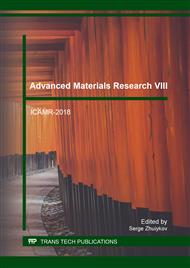p.237
p.243
p.249
p.255
p.260
p.269
p.275
p.280
p.285
Design of Alternating Current Abrasive Magnetic Fluid Jet Generator Based on Permanent Magnet
Abstract:
During the test of DC(direct current) abrasive magnetic fluid technology,many bubbles and noises were generated near the graphite electrode , and the yellow green liquid was produced, which affected the further test.Through the study of graphite electrode, it was found that NaCl solution magnetic fluid produced hydrogen and chlorine gas after electrolysis. At the same time, chlorine gas dissolved in water to form yellow green liquid.The magnetic field of neodymium boron permanent magnet was equivalent to a mechanical stirring, which inhibited the production of chlorine gas.According to the difference of impressed current system, the abrasive magnetic fluid jet technology was divided into DC and AC(alternating current) .There was no electrode in AC abrasive magnetic fluid jet technology, so no gas or noise would be produced.The rotating magic ring permanent magnet produced alternating magnetic field, acting on the abrasive magnetic fluid to form an induced current.Under the action of the magnetic field, the electromagnetic force was applied to move along the circumferential direction to promote the motion of the abrasive magnetic fluid.
Info:
Periodical:
Pages:
260-265
Citation:
Online since:
March 2018
Authors:
Keywords:
Price:
Сopyright:
© 2018 Trans Tech Publications Ltd. All Rights Reserved
Share:
Citation:


